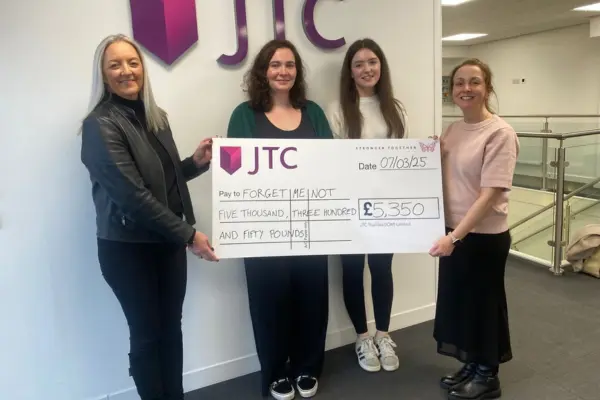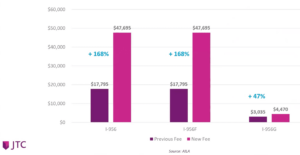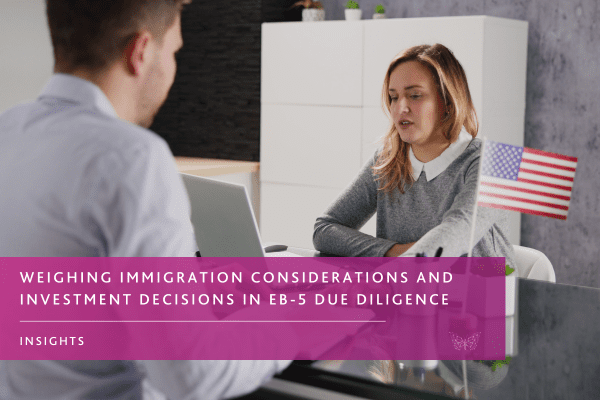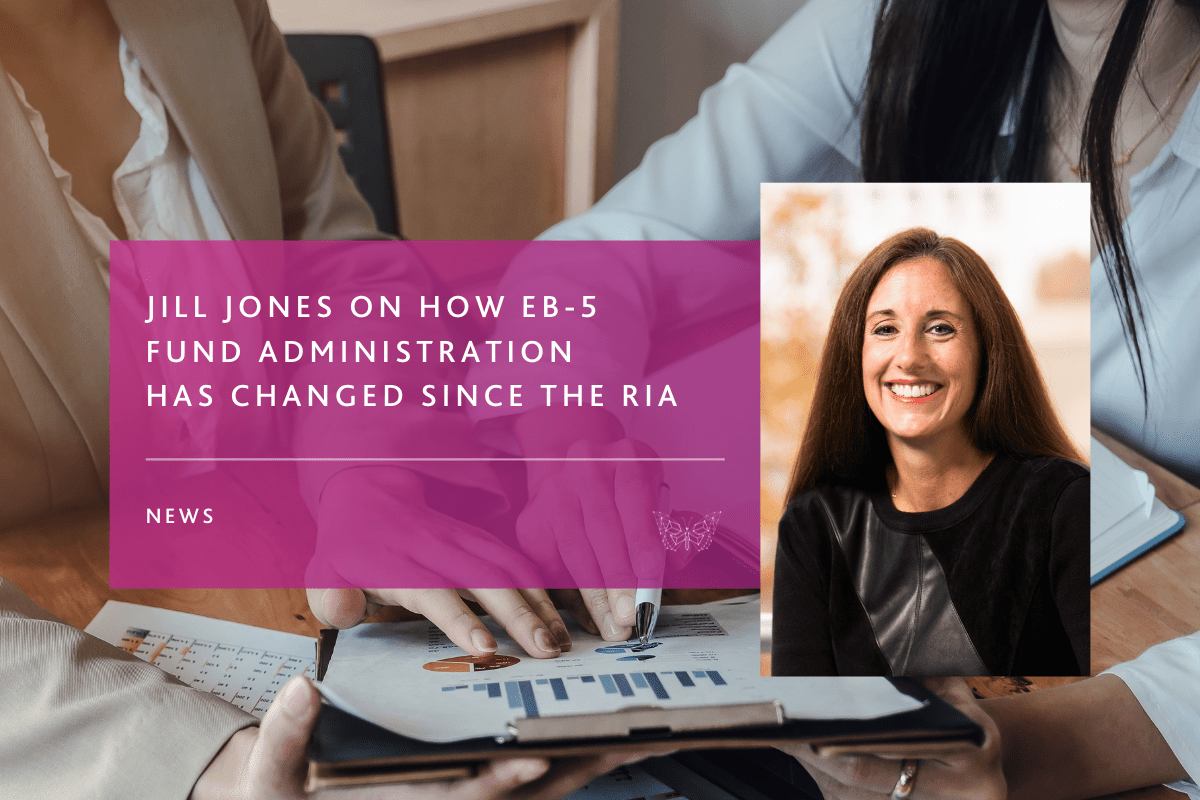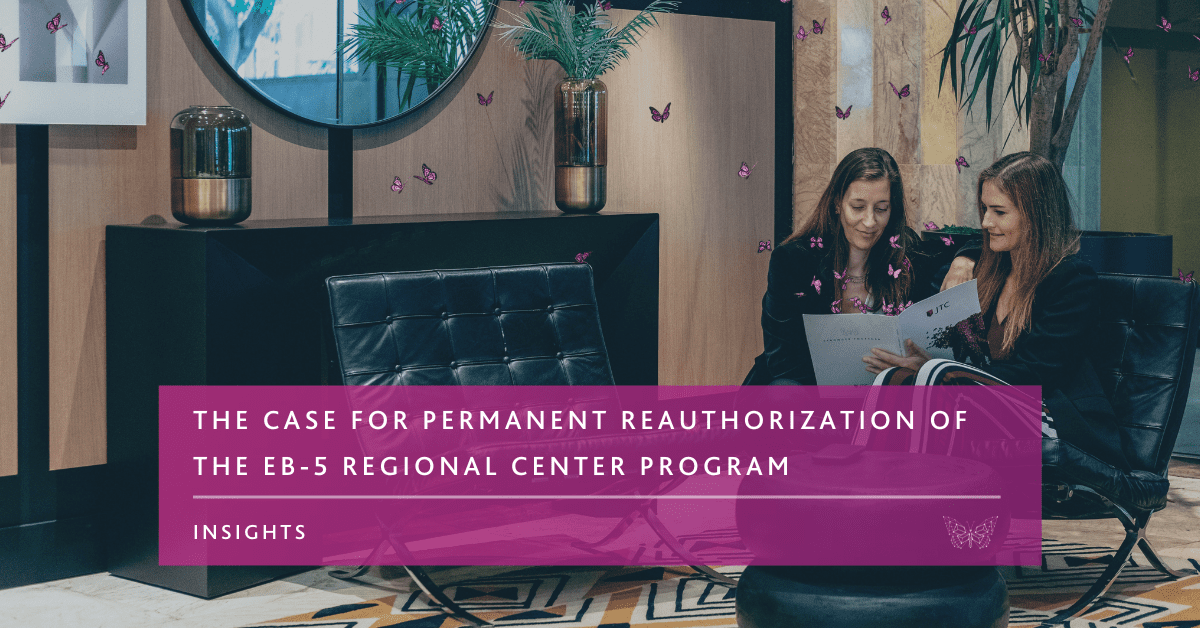With several lawsuits in process, industry stakeholders gathered to discuss their views on these cases and the hope for a better-managed program.
While the passage of the EB-5 Reform and Integrity Act of 2022 (RIA), which reauthorized the Regional Center program for five years, was welcomed by the EB-5 industry, it wasn’t without controversy. Almost immediately, there was litigation regarding the deauthorization of Regional Centers that operated before the RIA’s passage.
Legal fights between EB-5 stakeholders and United States Citizenship and Immigration Services (USCIS) have expanded, with several high-profile lawsuits challenging the agency’s interpretation and implementation of the RIA. How can EB-5 stakeholders proceed confidently when so many cases are still pending?
To sort through what is happening with these lawsuits, JTC gathered a panel of EB-5 experts for a webinar where they discussed the current state of EB-5 litigation. Now available to watch on demand, Securing EB-5’s Future: How Will Pending Litigation Impact the Industry?, featured panelists offering varied perspectives from across the EB-5 world as to the strengths and weaknesses of the various cases and what is necessary to achieve an efficient and fair EB-5 program.
Fee increases and the dual lawsuits addressing them
In early 2024, USCIS released a final rule that introduced massive fee hikes for both EB-5 investors and Regional Centers. Fees for I-956 and I-956F filings were increased 168%, while investor I-526 and I-526E fees increased 204%. This has resulted in two lawsuits, one from the American Immigrant Investor Alliance (AIIA) and one from a group of Regional Centers along with industry trade association Invest In the USA (IIUSA).
Regional Center Fee Changes
“To be in the EB-5 Regional Center game, it’s become a lot more expensive,” said Ishaan Khanna, President of AIIA. “It raises the barrier of entry” for newcomers, he said, because new Regional Centers have to pay both the I-956 and I-956F fees prior to going ahead with what could be a small first project, “all with the risk of not being 100% certain that you’ll be able to raise this money to begin with.” Khanna suggested a model where fees are charged based on the size of the project, which would encourage entry into the EB-5 space.
“The cost of doing business has increased dramatically,” echoed Kate Kalmykov, Shareholder, Greenberg Traurig. If there is a change to the size of the raise, the I-956F must be filed again with the changes, and the fee paid again. With each filing costing $47,695, that’s no small matter.
One major point made in legal filings is the fact that the RIA mandated a fee study be performed and fees increased accordingly however no fee study has been executed. “The Reform and Integrity Act mandated that fees be adjusted to reflect current conditions and costs however without a formal study or review, It appears that the raise in fees is arbitrary and unfair to the industry,” said JTC’s Jill Jones, who moderated the event.
“We were supposed to have a fee study first, and the fee study was supposed to have been done within a year,” said Carolyn Lee, Principal and Founder of Carolyn Lee PLLC. “The fee study has not been done, and there’s no correlation between these fees and the purpose of the fee study,” which was to set fees in a way that would allow USCIS to hit its targets for processing times.
“The fee increase has just been unfair,” agreed Khanna, who stressed that the lawsuits make several points: 1) there was no fee study, 2) the fee increases are too sharp and unfair to smaller operators, and 3) the new fees do not come with any guarantee of better or faster service from USCIS. It’s also likely Regional Centers may pass the increased costs onto investors, making the cost of applying for an EB-5 visa even higher.
Investor Related Fee Changes
“USCIS needs the money,” allowed Khanna. “In order to keep adjudicating cases in a timely fashion, they need the funds.” But by making EB-5 investors pay more simply because they can pay more, far more than other immigrant classes, it could drive potential applicants away from EB-5.
“When you increase the sunk costs that these immigrants pay, I think it disincentivizes a lot of them to come into this program,” said Khanna.
“The EB-5 program is an investor program, but it’s also a program for entrepreneurs,” said Lee. Adding at least two $47,695 payments to the cost of entry could be too high of a barrier for many on the Regional Center side. “If we had a notice and comment process, maybe the service would have heard that point,” she said.
The minimum sustainment period and IIUSA’s lawsuit
It took more than a year after the passage of the RIA for USCIS to clarify the law’s changes to the minimum investment sustainment period. Pre-RIA, investors had to sustain investments for their entire period of conditional residency, leading to what Khanna referred to as “horror stories of the pre-RIA investors whose investments had been reinvested again and again, oftentimes without their consent.”
In October of 2023, USCIS issued guidance clarifying that the minimum sustainment period would be two years. In addition to issues regarding how this period would actually be calculated and the increased risk involved in short-term projects, there are concerns that two years simply isn’t long enough to ensure a successful petition.
“If you really have a project that’s structured for two years according to the new guidance, you can get paid back before you get an adjudication,” said Kalmykov. “And there might be a problem, jobs may not be created, and you’ve already been exited out of your membership in the fund that gave EB-5 funds to the project, and now there’s no way to salvage or fix the situation.”
“More aggressive issuers may have these projects that are completely finished with an assumption that they’re compliant, and by the time they get to adjudication, if that’s not the current interpretation, it’s too late to fix it,” agreed Jones.
Concerns about how the new sustainment period was announced led to a lawsuit from industry trade association Invest In the USA (IIUSA). Much like the fee increase lawsuits, this filing deals with the procedural issues of a lack of notice and comment period, as well as the merits of the shortened sustainment period.
There has been much controversy surrounding IIUSA’s filing from those who believe it will lead to a return to the way things were pre-RIA. In the view of these critics, the two-year period, while not ideal, is still better than what we had before. Speaking from the perspective of investors, Khanna says the two-year minimum was welcomed.
“For them, the fact that the immigration period and the investment period have been separated is a huge plus,” said Khanna. “Whatever’s going on with immigration won’t impact the return of their funds.”
Khanna also pointed out that while investors have the choice of going with a two-year project, they’re free to go with a more traditional time frame.
“This new sustainment period is a floor, not a ceiling,” he said. “So, it really is up to the investor to do that due diligence.”
“If your loan has a five-year term, it’s got a five-year term,” stated Lee, stressing that investors need to understand that just because two years is the minimum, that doesn’t mean their preferred project will accommodate.
“Many projects will need to keep funds longer to bring the project to completion,” said Kalmykov, who added that from her experience, investors are largely okay with longer periods “if it means that their investment is safer and will be returned to them at the end.”
Conflict over the rollover of set-aside visas
Another suit filed by IIUSA deals with the treatment of the RIA’s set-aside visas. As most in the industry know, rural and urban high-unemployment projects have become highly sought-after since the RIA implemented reserved visas for those categories. The issue is what happens with visas for those categories if they go unused in a given year.
Presently, any unused set-aside visas roll over to the set-aside category for the following year. The year after that, if still unused, they go to the EB-5 unreserved visa pool. If still unused the year after that, they are released to other categories such as EB-1.
Because it took so long to get clarification on many parts of the RIA and for the industry to resume business as usual following the law’s passage, essentially all 2022 set-asides and many from 2023 were rolled over before there was any chance of their being used. They are now set to be released to the unreserved category (and eventually to other visa categories) not through a lack of investor interest, but because there wasn’t time for investors to use them before they rolled over.
As Khanna explained at the webinar, investors shouldn’t lose out on visas due to the speed with which the program – and USCIS – is operating.
“There’s been enough delays as is on adjudication,” said Khanna.
“Historically, we’ve lost a lot of EB-5 numbers, and it hasn’t been fair,” agreed Kalmykov, who made the case that EB-5 investors should be prioritized because of what they bring to the country, not penalized by slow adjudication.
“We can’t deny the fact that EB-5 investors are benefiting the country at no cost to U.S. taxpayers,” she said. “They should not be disadvantaged – if anything, they should be encouraged.”
“There’s plenty of people in the queue; they’re just not in the right category, or they filed before the RIA was enacted and they’re stuck waiting,” said Jones, who agreed that investors shouldn’t lose out on visas due to delays that they didn’t cause. However, Jones said, as of now, the issue is “at the mercy of the courts.”
Resolved litigation – what progress has been made through legal action?
While it can sometimes seem that EB-5 litigation stretches on forever, there have been some achievements made in recent months. Early in 2024, a number of Regional Centers received Notices of Intention to Terminate (NOITs) related to unpaid fees. Had these Regional Centers been terminated, it would have endangered petitions for a lot of innocent investors.
“There are so many investors under each of these Regional Centers, it put a lot of people in jeopardy,” said Jones.
Following legal action, USCIS announced affected Regional Centers would be allowed to pay the outstanding fees to continue operating. While this is good news, the webinar panelists noted that we can’t count on this type of leniency in the future.
“I do think their guidance was pretty clear on this,” Kalmykov. “I think it’s a one-time thing.”
Another recent case involved the path of funds requirement, hopefully lessening the burden placed on investors to prove the original source of their funds.
“Clients simply can’t go back 20, 30 years,” said Kalmykov. “I do think applying a standard that’s reasonable is important.” However, she cautioned that “the decision is limited in scope,” and the debate around this issue may not be over.
“The principles in there are important,” said Lee, who admitted that she’s still “struggling with” understanding the ramifications of this particular decision and what it means for the future.
It certainly isn’t ideal for the industry to have a litigation-filled, combative relationship with USCIS, but the alternative – proper communication – hasn’t been achieved even with industry pressure to foster a better environment.
“The doors of communication have largely been closed,” said Kalmykov.
“Litigation is a necessary means to arrive at lawful results,” said Lee, “but it is very costly.”
Nonetheless, it’s important to remember that from the Behring lawsuit in the aftermath of the RIA’s passage to the recent developments regarding NOITs and path of funds, lawsuits have achieved some progress.
“Really what we want people to take away from today is litigation is not always bad,” said Jones. “Sometimes it brings good results, and as far as we are today in what’s ongoing, things are looking good.”
Kalmykov said that from her interactions with EB-5 investors, she’s found that they’re generally up-to-speed on EB-5 litigation and want to know what Regional Centers’ plans are regarding different contingencies. “Investors nowadays are very well-informed,” she said.
Given that investors are likely to ask what a Regional Center’s views are on pending litigation and what will be done in the event of various outcomes, it’s important to have not only a full understanding of what is happening in the industry, but proper communication with investors, who want to feel that they’re hearing from their Regional Center about these developments.
We can’t know when or how the courts might resolve these issues, but Regional Centers can assure investors that they’ll be on top of any changes and provide information when it comes. This is another instance where the cream will rise to the top, as the best Regional Centers that foster the best communication will set themselves apart.
Stay Connected
Stay up to date with expert insights, latest updates and exclusive content.
Discover more
Stay informed with JTC’s latest news, reports, thought leadership, and industry insights.
Let’s Bring Your Vision to Life
From 2,300 employee owners to 14,000+ clients, our journey is marked by stability and success.



